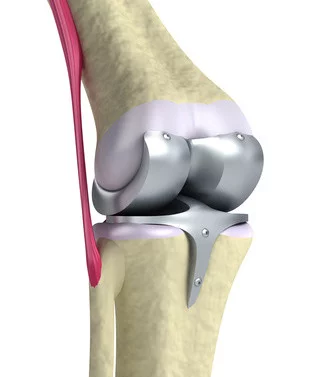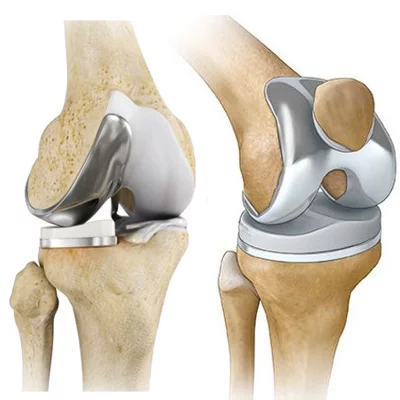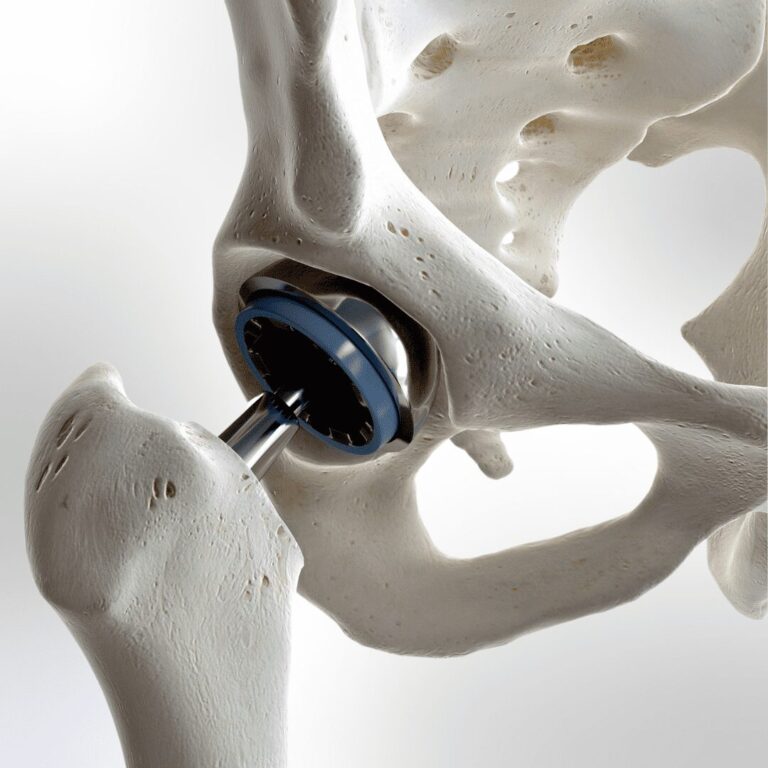Knee Replacement Surgery Guide: All You Need to Know
Knee replacement surgery, also known as knee arthroplasty, is a surgical procedure that involves replacing either a portion or the entire knee joint. During the surgery, your surgeon will replace damaged cartilage and bone with a prosthetic joint. While the recovery process can take up to a year, gradual resumption of your normal activities is possible as you heal. This transformative procedure offers the opportunity for improved mobility and enhanced quality of life. In this guide, The More Clinics invites you to explore every aspect, ensuring you make informed decisions about your orthopedic health including costs, recovery and knee replacement surgery Turkey option.

What Is Knee Replacement Surgery?
Knee replacement surgery, or knee arthroplasty, is a crucial orthopedic procedure that replaces the damaged part of the knee with artificial parts. The knee, a hinge joint connecting the thigh bone to the shinbone, can become damaged due to arthritis, injury, or other conditions, leading to pain, stiffness, and difficulty in movement.
In the knee replacement process, the damaged bone and cartilage are removed and replaced with prosthetic components made of metal, plastic, or a combination of both. These artificial parts mimic the function of a natural knee, enabling patients to return to their regular activities with reduced pain and improved mobility. The surgery may involve the replacement of the entire knee (total knee replacement) or only a part of it (partial knee replacement), depending on the extent of the damage.

Knee Replacement Surgery Success Rates
Knee replacement surgery has evolved into a commonplace procedure performed in numerous hospitals. Each year, an estimated 600,000 total knee replacements are conducted by skilled surgeons across the United States.
- According to the American Academy of Orthopedic Surgeons (AAOS), 90 percent of individuals experience significant pain relief after knee replacement surgery.
- Over 90 percent of replacement knees are still functional after 15 years, as reported by the AAOS.
- Research published in 2019 shows that 82 percent of total knee replacements are still functional after 25 years.
Types of Knee Replacement Surgery
There are primarily two types of knee replacement surgery: Total Knee Replacement (TKR) and Partial Knee Replacement (PKR).
Total Knee Replacement (TKR): Also known as total knee arthroplasty, this procedure involves replacing all three components of the knee joint – the inner (medial), outer (lateral), and front (patellar) parts. TKR is typically performed on patients with advanced arthritis or those who have severe knee damage.
Partial Knee Replacement (PKR): Also known as unicompartmental knee replacement, this procedure involves replacing only the damaged part of the knee, preserving as much of the natural knee as possible. PKR is usually recommended for patients whose arthritis or damage is limited to one specific area of the knee.
Each of these surgical options has its advantages and drawbacks, with the choice of procedure largely dependent on the extent of the knee damage, the patient’s overall health, age, and lifestyle. It’s crucial to discuss these options thoroughly with your doctor to decide the best course of action for your specific case.
Who Is the Best Candidate for Surgery?
Knee replacement surgery is generally considered when other treatment options fail to provide relief from the debilitating symptoms of knee issues. It is most commonly performed to treat:
- Severe osteoarthritis: This condition occurs when the protective cartilage that cushions the ends of your bones wears down over time, causing pain, swelling, and stiffness in the knee joint.
- Rheumatoid arthritis: This is a chronic inflammatory disorder that can affect more than just your joints. In some people, the condition can damage a wide variety of body systems, including the skin, eyes, lungs, heart, and blood vessels.
- Post-traumatic arthritis: This form of arthritis is characterized by the wearing out of a joint that has had any kind of physical injury. The condition may surface years after a damaging knee incident, such as ligament injury, meniscus tear, or knee fracture.
- Bone dysplasias or deformity: Certain congenital abnormalities or bone diseases can cause knee joint deformation, necessitating a knee replacement surgery.
Identifying the root cause of your knee issues can help you and your doctor determine if knee replacement surgery is the right solution for you. Always consult with a healthcare professional to discuss the potential benefits and risks associated with the procedure.
Any Alternative to Knee Replacement
Before opting for surgery, it’s important to explore all possible alternatives. These could include conservative treatments such as physical therapy or medications.
Physical therapy may improve knee mobility and strengthen the muscles around the knee, thus reducing pain.
Medications such as nonsteroidal anti-inflammatory drugs (NSAIDs), corticosteroids, or hyaluronic acid may provide temporary relief from pain and inflammation. Other alternative treatments could include the use of assistive devices like canes or knee braces, lifestyle changes (such as weight loss and low-impact exercise), or procedures like steroid injections or arthroscopy.
However, while these alternatives can sometimes provide relief, they typically can’t stop the progression of conditions like arthritis. Therefore, knee replacement surgery may ultimately be necessary for long-term improvement of knee function.
Knee Replacement Surgery Benefits
- Improved mobility: Patients regain the ability to walk, climb stairs, and engage in gentle exercise.
- Enhanced quality of life: Chronic pain is relieved, improving overall mood and reducing dependency on others.
- Return to regular activities: Patients can resume hobbies and occupations previously limited by knee pain.
- Improved sleep: Alleviating knee pain leads to better sleep patterns.
Risks
Like any surgical intervention, knee replacement surgery comes with its share of potential risks and complications. It’s important to note that these risks are relatively rare, but being aware of them can provide a more comprehensive understanding of the procedure.
Infection: Post-surgical infections can take place in the wound or deeper around the artificial joint. Minor infections are generally treated with antibiotics, but severe cases may require additional surgery or even replacement of the artificial joint.
Blood Clots: Clots can form in the leg veins as a consequence of surgery. These can be life-threatening if they dislodge and travel to the heart, lungs, or brain.
Continued Pain: A small percentage of patients may continue to experience pain after surgery. Your doctor will help you manage this with appropriate medications.
Loosening of the Prosthesis: Over time, the artificial joint may loosen from the bone, causing pain. If the loosening is significant, revision surgery may be required.
Nerve Damage: Although rare, nerve damage can occur during surgery.
To minimize these risks, it’s crucial to choose a highly experienced surgeon, follow all pre and post-operative instructions, and maintain a healthy lifestyle. Discuss all your concerns with your healthcare provider before making a decision.
Step-by-Step Procedure
The step-by-step procedure for knee replacement surgery begins with the administration of anesthesia to the patient. The surgeon then makes an incision over the affected knee to expose the joint. The damaged parts of the knee joint are removed from the surface of the bones, and the surfaces are then shaped to hold a metal or plastic artificial joint. The artificial joint is attached to the thigh bone, shin, and knee cap either with cement or a special material. When fit together, the attached artificial parts form the joint, relying on the surrounding muscles and ligaments for support and function. After the surgery, you’ll be moved to the recovery room, where staff will monitor you as you wake up from anesthesia. The procedure typically takes about one to two hours.
Knee Replacement Surgery Recovery Timeline and What to Expect
The recovery timeline for knee replacement surgery is unique to each individual, but there is a general framework of what to expect:
Immediately after surgery: You will be moved to a recovery room where medical staff will monitor your vital signs as the anesthesia wears off. You may feel some pain, which can be managed with medication.
First 24 hours: You’ll likely start physical therapy within 24 hours after surgery. The medical team will assist you in performing simple exercises in your bed.
1-2 days post-surgery: You should be able to stand with assistance and begin walking using a walker or crutches. Your pain should be manageable with medication.
3 days to a week: Discharge from the hospital usually occurs within this timeframe, depending on your progress. You’ll continue physical therapy at home or at a rehab center.
2 weeks: You may be able to move around the house without crutches or a walker. The stitches or staples will be removed.
3-6 weeks: You can expect gradual improvement in your mobility. Walking, climbing stairs, and light household activities should be possible. Continue with physical therapy throughout this period.
3 months: Most people can drive again and engage in low-impact activities like swimming or cycling.
6 months: By this time, you should be able to return to most of your normal activities, including more demanding ones like hiking or tennis.
1 year: Most patients experience significant or total relief from pre-surgery pain and substantial improvement in the function of their knee.

Remember, while most people experience a significant reduction in pain and improvements in their quality of life, full recovery can take up to a year. During this time, it’s crucial to keep up with physical therapy and gradually increase your level of activity to achieve the best outcome. Always consult with your healthcare provider about what’s appropriate for your individual circumstance.
Knee Replacement Surgery Cost by Country
The cost of knee replacement surgery can vary significantly depending on the country where the procedure is performed. Here’s a rough estimate of the costs in several countries, although actual costs may vary based on specific circumstances and healthcare providers:
United Kingdom (UK): In the UK, knee replacement surgery is mostly covered under the National Health Service (NHS), so the cost to the patient is minimal. However, for private healthcare, the cost can range between £11,000 and £15,000.
United States (USA): In the USA, the cost for a knee replacement can vary widely, depending on the state and the hospital. On average, the cost ranges from $45,000 to $70,000. However, the cost is usually covered by health insurance providers to some extent.
Canada: In Canada, knee replacement surgery is covered under the public health care system, so there is minimal cost to the patient. However, for non-residents or those opting for private healthcare, the cost can range from CAD 20,000 to CAD 30,000.
Germany: In Germany, the cost of a knee replacement surgery can range from €12,000 to €20,000. The German statutory health insurance covers all or the majority of these costs.
Ireland: In Ireland, the cost of knee replacement surgery in private hospitals can range between €15,000 and €22,000.
Remember, these are just average costs and can vary depending on various factors like the hospital, surgeon’s fee, type of implant used, and any additional healthcare needs. Always consult with your healthcare provider and insurance company to understand the costs involved better.
Knee Replacement Turkey as an Affordable and Qualified Option
When considering knee replacement surgery, one of the significant factors is the cost. In the United States, the surgery can be quite expensive, often ranging from $20,000 to $50,000, depending on various factors, including the type of surgery and the geographic location. On the other hand, Turkey has emerged as a popular and affordable destination for this type of medical procedure due to the combination of cost-effective and high-quality medical services. The country boasts of world-class medical facilities, specialized orthopedic hospitals, and highly experienced surgeons, all at a fraction of the cost compared to the U.S. Depending on the specific case, it’s possible to save up to 70% on the cost of knee replacement surgery by choosing to have it done in Turkey. Also, the cost typically includes all related medical expenses, such as hospital stay, physical therapy, and follow-up care, providing a comprehensive and affordable solution for those seeking this procedure.
Last Words from the The More Clinics Turkey
The knee replacement surgery can significantly improve your quality of life by alleviating pain and enhancing mobility. The cost varies greatly by country and can be quite high in places like the United States. However, Turkey offers a cost-effective and high-quality alternative, potentially saving you up to 70% on surgery costs. This affordable solution includes all medical expenses, ensuring a comprehensive and worry-free experience. If you’re considering knee replacement surgery, don’t let the cost deter you. Reach out to us at The More Clinics Turkey for a free consultation and begin your journey towards a pain-free life.
GET A FREE CONSULTATION!
Let’s Start Planning Your Treatment %100 Guarantee Results.






